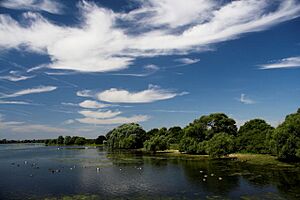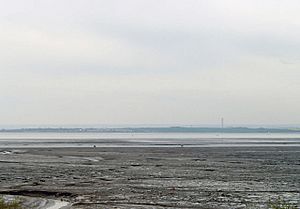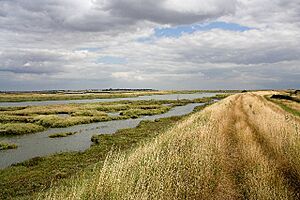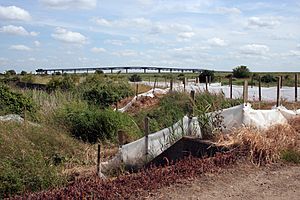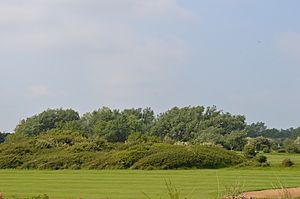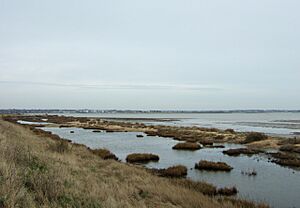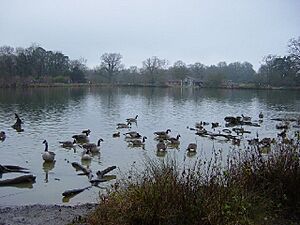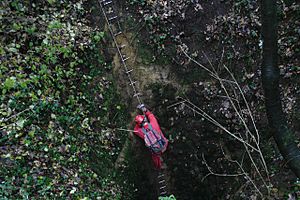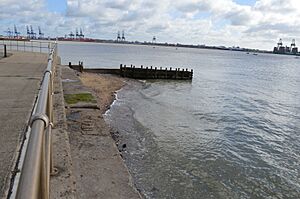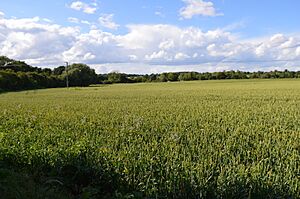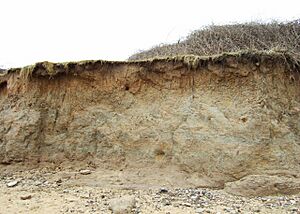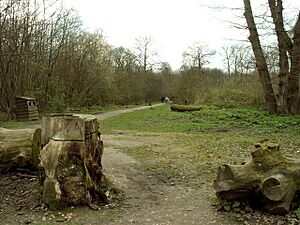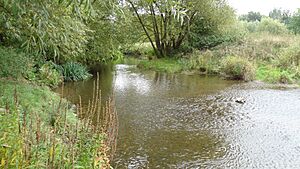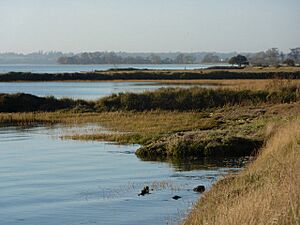List of Sites of Special Scientific Interest in Essex facts for kids

Essex is a county in the east of England. It's a place with a long history, once known as the Kingdom of the East Saxons. Today, it shares borders with Suffolk, Cambridgeshire, Hertfordshire, Greater London, and Kent (across the River Thames). To the east, it meets the North Sea.
Essex covers about 1,420 square miles (3,678 square kilometers) and has a long coastline of 400 miles (644 kilometers). Around 1.4 million people live here.
In England, special places for nature are called Sites of Special Scientific Interest (SSSIs). These sites are chosen by an organization called Natural England. Their job is to protect England's natural environment. Being an SSSI means a place gets legal protection because it's important for wildlife or geology.
As of August 2016, there were 86 SSSIs in Essex. Some are important for their plants and animals (biological interest). Others are important for their rocks and landforms (geological interest). A few are special for both reasons!
The biggest SSSI in Essex is Foulness. It's super important for birds like wildfowl and waders. It's also home to 71 types of invertebrates (like insects and spiders) that are rare in the country.
The smallest SSSI is Holland-on-Sea Cliff. This is a geological site. It helps scientists understand where the River Thames flowed a very long time ago. About 450,000 years ago, during the Anglian glaciation (an ice age), the river was moved south.
Some SSSIs have really cool features. Hangman's Wood and Deneholes has old deneholes. These are shafts dug by people in medieval times to mine for chalk. Now, bats use them to hibernate (sleep through winter). Lion Pit is another amazing site. Neanderthals made flint tools here about 200,000 years ago. Scientists have even been able to fit some of the flint pieces back together!
Contents
- What are SSSIs?
- Amazing SSSIs in Essex
- Abberton Reservoir
- Ardleigh Gravel Pit
- Benfleet and Southend Marshes
- Blackwater Estuary
- Canvey Wick
- Clacton Cliffs and Foreshore
- Colne Estuary
- Epping Forest
- Hatfield Forest
- Hangman's Wood and Deneholes
- Harwich Foreshore
- Lion Pit
- Marks Tey Brickpit
- The Naze
- Norsey Wood
- Roding Valley Meadows
- Stour Estuary
- Tiptree Heath
- Images for kids
- See also
What are SSSIs?
SSSIs are like special nature reserves. They protect the best examples of England's wildlife and geological features. This protection helps make sure these important places are safe for the future.
Why are SSSIs important?
- Protecting rare species: Many SSSIs are home to plants and animals that are rare or endangered.
- Studying Earth's history: Geological SSSIs help scientists learn about ice ages, ancient rivers, and how our planet has changed.
- Keeping habitats healthy: They protect different types of natural areas, like woodlands, marshes, and grasslands.
Amazing SSSIs in Essex
Let's look at some of the interesting SSSIs in Essex and what makes them special.
Abberton Reservoir
This huge reservoir is super important for birds. Many wigeons spend the winter here. It's also a national hotspot for twelve other types of waterfowl. You can even see cormorants nesting in trees, which is quite unusual!
Ardleigh Gravel Pit
This site is a window into the past. It shows layers of earth from different warm periods between ice ages. One layer is from the Hoxnian Stage, about 400,000 years ago. It even has tiny plant fossils from a very cold period.
Benfleet and Southend Marshes
These marshes and mudflats are vital for birds. Thousands of wildfowl and waders, like dark-bellied brent gooses and grey plovers, visit here. Some parts are also important for rare invertebrates, including white-letter hairstreak butterflies.
Blackwater Estuary
This estuary is another international bird haven. It hosts huge numbers of wintering dark-bellied brent geese and dunlin. It's also home to sixteen types of invertebrates that are on the Red List of Threatened Species, meaning they are at risk of disappearing.
Canvey Wick
Canvey Wick is a fantastic place for invertebrates. It has a nationally important population of these creatures. Twenty-two species found here are on the Red List. Three species were even thought to be extinct in Britain before being found here! It's also a key spot for the rare shrill carder bee.
Clacton Cliffs and Foreshore
These cliffs tell a story from 400,000 years ago. Flint tools found here show that early humans, like homo erectus, lived and worked here. This site is famous for the "Clactonian" tools, which are a type of stone tool.
Colne Estuary
The Colne Estuary has many different habitats, from saltmarshes to shingle beaches. It's internationally important for wintering brent geese and black-tailed godwits. Six other bird species are also nationally important here.
Epping Forest
Epping Forest is an ancient woodland with grasslands and wetlands. Natural England says its invertebrate life is "outstandingly nationally significant." This includes 66 types of insects that live under bark or in dead wood, many of which are on the Red List.
Hatfield Forest
This is the last Royal Forest in England that is still mostly untouched. It has ancient woodlands, grasslands, a large lake, and marshes. The forest is home to many rare plants and over sixty different bird species. It's like stepping back in time!
Hangman's Wood and Deneholes
This SSSI is special for its deneholes. These are old shafts dug for chalk mining in medieval times. Now, they are super important for bats. Three species, including the Brown long-eared bat, use these underground spaces to hibernate. The ancient oak woodland above provides food for the bats.
Harwich Foreshore
This coastline shows layers of ash from ancient volcanoes in Scotland, about 50 million years ago! It also has many fossils from the Eocene rainforest, including early mammals like Hyracotherium, which was an ancestor of the horse. It's a great place to learn about ancient life.
Lion Pit
At Lion Pit, scientists found evidence of Neanderthals making flint tools 200,000 years ago. They even managed to fit some of the flint pieces back together, like a puzzle! Fossils of ancient animals like rhinoceros, bison, and mammoths have also been found here.
Marks Tey Brickpit
This site has an amazing record of pollen from the Hoxnian Stage (a warm period) about 400,000 years ago. It's the best plant record from any British interglacial site. Scientists have even used the layers in lake sediments to guess how long the Hoxnian period lasted.
The Naze
The Naze is a very important geological site. It's where the "Waltonian," the first British stage of the Pleistocene ice age, was first identified. It also has many plant and bird fossils from the Eocene epoch. Scientists use this site to study how birds have changed over millions of years.
Norsey Wood
This is an ancient oak woodland. It has special mosses in wet areas and the rare water violet in one of its ponds. Nine types of dragonflies live here. You can also find Bronze Age burial mounds, showing people lived here a very long time ago.
Roding Valley Meadows
These meadows are next to the River Roding. They are one of the largest areas of grassland in Essex that are still managed in traditional ways. This means they are used for hay and are allowed to flood naturally. They have the biggest beds of the rare brown sedge in Essex.
Stour Estuary
This estuary is nationally important for thirteen types of wintering wildfowl. It's also special for its saltmarshes, muddy shores, and rare marine invertebrates. It even has three geological sites within it, making it a very diverse SSSI.
Tiptree Heath
Tiptree Heath is the biggest area of heathland left in Essex. It's covered in heather and bent grass. A small herd of Dexter cattle helps keep the heath healthy by eating plants that would otherwise take over. It's a great example of how animals can help manage a natural habitat.
Images for kids
See also
- List of Local Nature Reserves in Essex
- Essex Wildlife Trust


